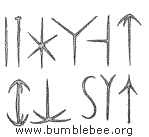
Monday, May 11, 2009
|
|
37th Common
|
|
Join Date: Mar 2006
Posts: 1,514
Thanks: 1,053
Thanked 1,681 Times in 873 Posts
|
|
 Invertebrate Short Notes
Invertebrate Short Notes
Spicules Spicules are tiny spike-like structures of diverse origin and function found in many organisms, such as the copulatory spicules of certain nematodes or the grains on the skin of some frogs.
This article discusses the skeletal spicules that occur in most sponges. They provide structural support and deter predators. Large spicules, visible to the naked eye are referred to as megascleres, while smaller, microscopic ones are termed microscleres.
Spicules have four major symmetry types: Monaxon (simple cylinders with pointed ends), triaxon, tetraxon, and polyaxon. Sponges can be calcareous, siliceous, or composed of spongin. The meshing of many spicules serves as the spongeís skeleton. The composition, size, and shape of spicules is one of the largest determining factors in sponge taxonomy.
Spicules are formed by sclerocytes, which are derived from archaeocytes. The sclerocyte begins with an organic filament, and adds silica to it. Spicules are generally elongated at a rate of 1-10 μm per hour. Once the spicule reaches a certain length it protrudes from the sclerocyte cell body, but remains within the cellís membrane. On occasion, sclerocytes may begin a second spicule while the first is still in progress.
Research on the Euplectella aspergillum (Venus' Flower Basket) demonstrated that the spicules of certain deep-sea sponges have similar traits to Optical fibre. In addition to being able to trap and transport light, these spicules have a number of advantages over commercial fibre optic wire. They are stronger, resist stress easier, and form their own support elements. Also, the low-temperature formation of the spicules, as compared to the high temperature stretching process of commercial fibre optics, allows for the addition of impurities which improve the refractive index. In addition, these spicules have built-in lenses in the ends which gather and focus light in dark conditions. It has been theorized that this ability may function as a light source for symbioticalgae (as with Rosella racovitzae) or as an attractor for shrimp which live inside the Venus' Flower Basket. However, a conclusive decision has not been reached; it may be that the light capabilities are simply a coincidental trait from a purely structural element. 


|